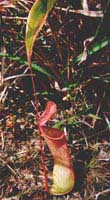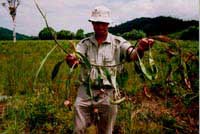Research on nutrient acquisition by different species of carnivorous plants
You can click on the individual species to view detailed photographs of these plants in their natural habitat and to get more information about each species (it will open in a new browser window).
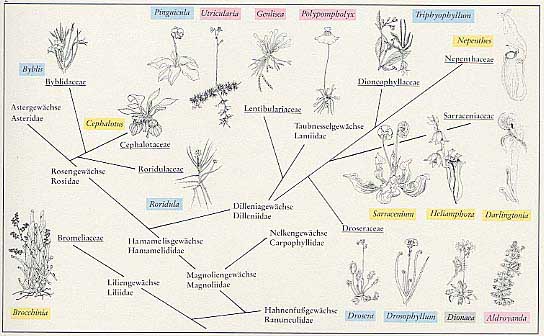
The table shows a comparison of different carnivorous plants with respect to the amount of plant nitrogen obtained from insect nitrogen. The values have been calculated by using the natural abundance of stable nitrogen isotopes. Data have been collected from plants growing all over the world, i.e. Nepenthes (Australia), Cephalotus (Australia), and several species of Australian Drosera, Darlingtonia (USA), Dionaea (USA), and Heliamphora and Brocchinia (Venezuela).
| capturing organ | genus | growth form | insect N per total N (%) | n |
| sticky leaves | Drosera | rosette | 19.6 E11 | 3 populations |
| vine | 52.9 E 24 | 4 species | ||
| erect low | 48.5 E 11 | 3 species | ||
| erect high | 53.7 E 10 | 3 species | ||
| pitcher | Cephalotus | rosette | 26.1 E 6 | 3 sites |
| Nepenthes | vine | 61.5 E 7 | 5 plants | |
| Darlingtonia | rhizome | 76.4 E 9 | 5 plants | |
| Heliamphora | rhizome | 79.3 E 4 | 5 plants | |
| Brocchinia | erect rosette | 59.8 E 2 | 3 sites | |
| suction trap | Polypompholyx | 20.1 E 10 | 2 plants | |
| moving leaf trap | Dionaea | rosette | 80.4 E 4 | 3 sites /30 plants |
Some photos of carnivorous plants in the experiments or in the field |
In this experiment, growth of Drosera
rotundifolia was measured at different rates of insect capture.
Leaves were marked to estimate the life spans of each leaf and calculate
leaf turnover. |
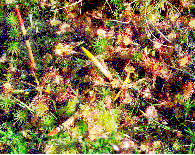 |
Nepenthes
mirabilis from Australia is an ideal plant to study the change
of nitrogen source from soil to insects. It grows long branches with
pitchers attached to phyllodes. The youngest pitchers are still active
and thus receive mainly insect nitrogen, whereas older leaves and
old pitchers are supported more and more by soil nitrogen. |
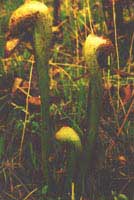 |
Darlingtonia (left), the
Californian pitcher plant. It grows its pichers from a rhizome and
it has noadditional leaf organs. Sometimes a frog lives in the pitchers
of Cephalotus (right), eventually stealing the plant's prey.
Cephalotus has its pitchers close to the ground and grows normal
leaves in a rosette in additon to pitchers. |
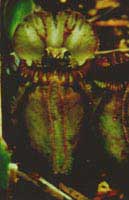 |
Dionaea has a unique trapping
mechanism consisting of two moving leaf lobes. The growth of Dionaea
in nature is restricted to very special habitats characterized by
regular bush fires to keep competing vegetation low (left). |
||
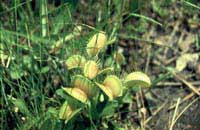 a Dionaea plant with big traps |
During succession after fires, Dionaea
is rapidly overgrown by competing grasses (right). |
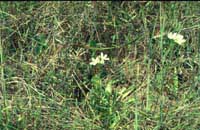 Dionaea is being overgrown by grasses |
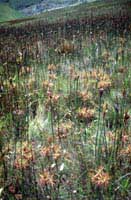 |
Roridula (left), growing in South Africa, is
not a real carnivorous plant. Moreover the bugs on its leaves eat
the captured insects and the plant utilizes the nitrogen from the
feces of the bug. |
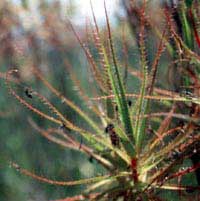 |
The "Mouth" of Nepenthes - Expression of Transporters for Ammonium, Amino Acids, and Peptides in Pitchers of Nepenthes alata |
| Waltraud Schulze,
Wolf Frommer, and John Ward ZMBP, Universität Tübingen |
|
Carnivorous plants,
such as Nepenthes, are adapted to a nutrient poor environment
and supplement their nitrogen budget by the capture and digestion
of insects. The contribution of insect nitrogen to total plant nitrogen
can be up to 70% of the plant's nitrogen content.
At the same time the plant invests a substantial amount of resources into the development of special trapping organs and digestive system. The uptake of nutrients from the pitcher fluid and the transport to other plant organs are important steps in the nitrogen acquisition from pitchers. However, very little is known about the molecular mechanisms involved. |
|
 |
Three genes encoding transporters for either ammonium (NaAMT1), amino acids (NaAAP1) or peptides (NaPTR1) were cloned from Nepenthes pitchers. The expression of these transporters in pitchers of different ages, with and without prey were analyzed by northern blots and in-situ hybridization. Pitchers absorb nitrogen in the form of ammonium, amino acids, and possibly peptides. Transporters for all of these nitrogenous compounds are expressed in pitchers, the expression of NaAMT1 and NaPTR1 was found to be pitcher specific. Expression of these transporters increased upon the presence of prey in the pitchers, but no increase in expression was observed upon feeding the pitchers with the substrates of the transporters. Expression of NaAMT1 increased with the time a pitcher was open (i.e. with age), the expression of NaPTR1 doubled upon pitcher opening, and the expression of NaAAP1 was highest in closed pitchers. In-situ hybridization (see figure at left) demonstrated a differential expression of the transporters within the pitcher. NaAMT1 was expressed in the head cells of digestive glands of the inner epidermis (a), NaAAP1 in the sclerenchymatic bundle sheath cells (b), and NaPTR1 is expressed in phloem (c). |
A function of NaAMT1
in uptake of ammonium from the pitcher fluid, of NaAAP1 in transport
of amino acids into the vascular tissue, and of NaPTR1 in phloem loading
with peptides is discussed. This indicates an efficient nitrogen concentration
mechanism allowing for maximum nitrogen export to sink organs. |
|
Carnivorous plants

Interactive Phylogeny
Quantification of insect-derived nitrogen-utilization
from insects
Photos from carnivorous plants in the field
Uptake mechanisms for nitrogen in pitcher plants
